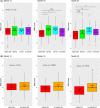Neighbourhood socio-economic environment predicts adiposity and obesity risk in children under two
- PMID: 36350200
- PMCID: PMC9788269
- DOI: 10.1111/ijpo.12964
Neighbourhood socio-economic environment predicts adiposity and obesity risk in children under two
Abstract
Background: Neighbourhood socio-economic environment (SEE) is associated with obesity in older children and adults, but little is known about this relationship in younger children. Breastfeeding is an important preventative of adiposity in childhood, but its relationship with neighbourhood SEE is unknown.
Aims: We assessed differences in adiposity and obesity in children before age two by neighbourhood SEE, controlling for family socio-demographics and breastfeeding duration.
Materials and methods: Family socio-demographics, child body mass index z scores (BMIz), and breastfeeding duration were collected at periodic study visits from participants in PREVAIL (n = 245), a birth cohort in Cincinnati, OH. Addresses were assigned a Deprivation Index score, a validated measure of SEE, and dichotomized into highest SEE (least deprived quartile of scores) and not highest SEE (remaining quartiles). Longitudinal and Poisson models assessed differences in BMIz by SEE over the second year of life and obesity risk at age two, respectively (highest SEE, reference), while attenuation of obesity risk by breastfeeding duration was tested in mediation models.
Results: Residing outside of the highest SEE neighbourhoods was associated with an increased BMIz of 0.04 (95%CI 0.02, 0.06) per month of life and increased obesity risk at age two (aRR: 3.7, 95%CI 1.2, 16.2), controlling for family socio-demographics. Breastfeeding duration attenuated >9% of the obesity risk attributable to SEE (mediated RR: 3.4, 95%CI 1.1, 14.8).
Discussion: In the PREVAIL Cohort, residing outside of the highest SEE neighbourhoods predicted a significant increase in BMIz and obesity risk in children before age two, a relationship that was partially mediated by breastfeeding duration.
Conclusion: Breastfeeding support may play an important role in reducing obesity rates in children in lower SEE neighbourhoods.
Keywords: breastfeeding; child obesity; health disparities; social determinants of health; socio-economic environment.
© 2022 The Authors. Pediatric Obesity published by John Wiley & Sons Ltd on behalf of World Obesity Federation.
Conflict of interest statement
The authors declare that they have no known competing financial interests or personal relationships that could have appeared to influence the work reported in this paper.
Figures


References
-
- Fryar C, Carroll M, Afful J. Prevalence of overweight, obesity, and severe obesity among children and adolescents aged 2–19 years: United States, 1963–1965 through 2017–2018. NCHS Health E‐Stats. 2020.
-
- Kelsey MM, Zaepfel A, Bjornstad P, Nadeau KJ. Age‐related consequences of childhood obesity. Gerontology. 2014;60(3):222‐228. - PubMed
Publication types
MeSH terms
Grants and funding
LinkOut - more resources
Full Text Sources
Medical

